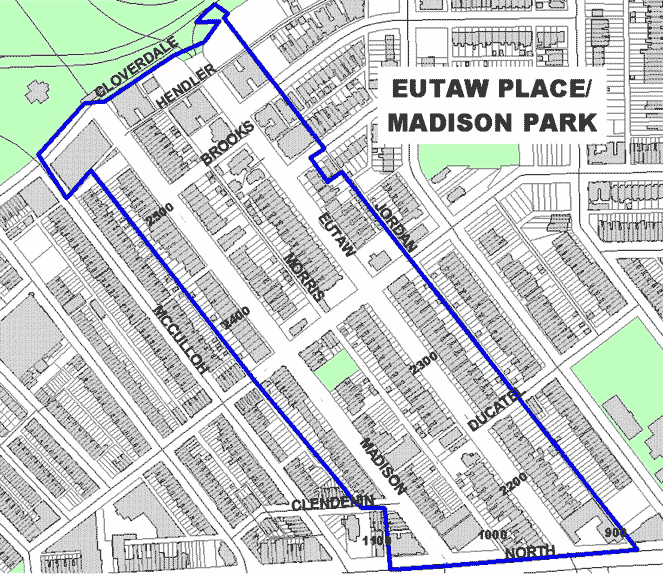Eutaw Place and Madison Park
Baltimore City Historic District Ordinance 407 7/2/81
Certified Historic District for Tax Incentives 2/25/83
Description
 The Eutaw Place/Madison Avenue Historic District consists of over twenty-five different groups of late nineteenth century to early twentieth century rowhouses, as well as a number of individual mansion houses and early twentieth century apartment buildings. These buildings were constructed along two gateway streets, Eutaw Place and Madison Avenue, which lead into Baltimore's largest Victorian-era park, Druid Hill Park.
The Eutaw Place/Madison Avenue Historic District consists of over twenty-five different groups of late nineteenth century to early twentieth century rowhouses, as well as a number of individual mansion houses and early twentieth century apartment buildings. These buildings were constructed along two gateway streets, Eutaw Place and Madison Avenue, which lead into Baltimore's largest Victorian-era park, Druid Hill Park.
The historic district, approximately the size of eight blocks, is located in an area known as Reservoir Hill approximately two miles northwest of the Inner Harbor. The houses of the area differ in style and detailing, but almost all maintain a common scale and proportion creating a unified linear streetscape. Many architectural styles are represented in the area including Italianate, Queen Anne and Renaissance Revival. There has never been any wholesale demolition in this district or much new intrusive construction, thus most streetscapes are intact.
Significance
The Eutaw Place/Madison Avenue district is primarily significant as one of the most architecturally distinguished late nineteenth to early twentieth century neighborhoods in Baltimore City. Its architecture embodies the distinctive characteristics of turn-of-the-century buildings styles highlighted in the area's more eclectic rows. A wide range of architectural styles exist in the area including classically oriented designs by important local architects for individual homes and apartments.
From an urban design perspective, the district is important in its relationship to Druid Hill Park as a gateway to the park. This gateway aspect of the district, the relatively early development of Madison Avenue and the large size and highly ornate character of Eutaw Place houses distinguishes Eutaw Place/Madison Avenue from the rest of Reservoir Hill. Eutaw Place/Madison Avenue was one of Baltimore's premiere turn-of-the-century neighborhoods. The area is historically significant in its associations with the lives of important citizens that lived in the fine houses of the district.